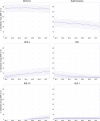Time trends and geographical variation in prescribing of drugs for diabetes in England from 1998 to 2017
- PMID: 29732725
- PMCID: PMC6099452
- DOI: 10.1111/dom.13346
Time trends and geographical variation in prescribing of drugs for diabetes in England from 1998 to 2017
Abstract
Aims: To measure the variation in prescribing of second-line non-insulin diabetes drugs.
Materials and methods: We evaluated time trends for the period 1998 to 2016, using England's publicly available prescribing datasets, and stratified these by the order in which they were prescribed to patients using the Clinical Practice Research Datalink. We calculated the proportion of each class of diabetes drug as a percentage of the total per year. We evaluated geographical variation in prescribing using general practice-level data for the latest 12 months (to August 2017), with aggregation to Clinical Commissioning Groups. We calculated percentiles and ranges, and plotted maps.
Results: Prescribing of therapy after metformin is changing rapidly. Dipeptidyl peptidase-4 (DPP-4) inhibitor use has increased markedly, with DPP-4 inhibitors now the most common second-line drug (43% prescriptions in 2016). The use of sodium-glucose co-transporter-2 (SGLT-2) inhibitors also increased rapidly (14% new second-line, 27% new third-line prescriptions in 2016). There was wide geographical variation in choice of therapies and average spend per patient. In contrast, metformin was consistently used as a first-line treatment in accordance with guidelines.
Conclusions: In England there is extensive geographical variation in the prescribing of diabetes drugs after metformin, and increasing use of higher-cost DPP-4 inhibitors and SGLT-2 inhibitors compared with low-cost sulphonylureas. Our findings strongly support the case for comparative effectiveness trials of current diabetes drugs.
Keywords: antidiabetic drug; cost-effectiveness; glycaemic control; primary care; type 2 diabetes.
© 2018 The Authors. Diabetes, Obesity and Metabolism published by John Wiley & Sons Ltd.
Conflict of interest statement
BG has received funding from the Health Foundation, the National Institute for Health Research School of Primary Care Research, the NIHR Biomedical Research Centre Oxford, the West of England Academic Health Sciences Network and NHS England for work on UK prescribing data. HC, AW and SB are employed on these grants. BG has additionally received funding from the Laura and John Arnold Foundation, the Wellcome Trust, and the World Health Organisation to work on better use of data in medicine; and receives personal income from speaking and writing for lay audiences on the misuse of science. JD, BS, AJ and AH have all received support for this work from the MRC as part of the MASTERMIND funding for stratified medicine. AH is a Wellcome Trust senior investigator and an NIHR senior investigator. AJ is supported by an NIHR Clinician Scientist award.
Figures




References
-
- NHS‐England . QOF 2015–16. http://www.content.digital.nhs.uk/searchcatalogue?productid=23378&q=qof&.... Published 2017. Accessed August 21, 2017.
-
- NHS Digital . Prescriptions Dispensed in the Community, England 2006 to 2016. Prescribing and Medicines Team, NHS Digital, UK. June 2017.
-
- NHS Digital . Prescribing for Diabetes, England ‐ 2006/07 to 2016/17. http://digital.nhs.uk/catalogue/PUB30043. Published August 1, 2017. Accessed September 25, 2017.
-
- NICE . Algorithm for blood glucose lowering therapy in adults with type 2 diabetes. https://www.nice.org.uk/guidance/ng28/resources/algorithm-for-blood-gluc.... Published 2015. Accessed December 20, 2017.
Publication types
MeSH terms
Substances
Grants and funding
LinkOut - more resources
Full Text Sources
Other Literature Sources
Medical
Miscellaneous

